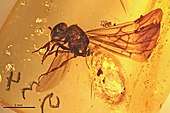1966 in paleontology
Paleontology or palaeontology is the study of prehistoric life forms on Earth through the examination of plant and animal fossils.[1] This includes the study of body fossils, tracks (ichnites), burrows, cast-off parts, fossilised feces (coprolites), palynomorphs and chemical residues. Because humans have encountered fossils for millennia, paleontology has a long history both before and after becoming formalized as a science. This article records significant discoveries and events related to paleontology that occurred or were published in the year 1966.
| |||
|---|---|---|---|
Arthropods
Newly named Insecta
| Name | Novelty | Status | Authors | Age | Unit | Location | Notes | Images |
|---|---|---|---|---|---|---|---|---|
|
Oligomyrmex antiqua[2] |
Comb nov |
jr synonym |
(Mayr, 1868) |
Middle Eocene |
Baltic amber |
Fossil myrmicine ant, |
 Carebara antiqua | |
|
Subfam. Gen. et sp. nov |
Valid |
New Jersey Amber |
Basal most ant subfamily. One genus Sphecomyrma |
|||||
Conodonts
| Name | Novelty | Status | Authors | Age | Unit | Location | Notes | Images |
|---|---|---|---|---|---|---|---|---|
|
Gen. nov |
Valid |
David L. Dunn |
||||||
Anapsids
Newly named mesosaurs
| Name | Novelty | Status | Authors | Age | Unit | Location | Notes | Images |
|---|---|---|---|---|---|---|---|---|
|
Gen. et sp. |
Valid |
Shikama & Ozaki |
Artinskian |
A mesosaur. |
||||
Dinosaurs
Newly named dinosaurs
Data courtesy of George Olshevsky's dinosaur genera list.[6]
| Name | Novelty | Status | Authors | Age | Unit | Location | Notes | Images |
|---|---|---|---|---|---|---|---|---|
|
Gen et sp nov |
Valid |
Rozhdestvensky |
early Cretaceous |
| ||||
Newly named birds
| Name | Novelty | Status | Authors | Age | Unit | Location | Notes | Images |
|---|---|---|---|---|---|---|---|---|
|
Arikarornis macdonaldi [8] |
Gen et sp nov. |
valid |
Middle Sharps Formation |
An Accipitrid, type species A. macdonaldi |
||||
|
Miortyx aldeni [8] |
Sp. nov. |
valid |
Howard |
Early Miocene |
Middle Sharps Formation |
An Odontophoridae. |
||
|
Diomedea milleri [9] |
Sp. nov. |
valid |
Howard |
A Diomedeid. |
||||
|
Dissourodes milleri [10] |
Gen et sp. nov. |
jr synonym |
Short |
Early Pliocene |
A Ciconiidae, jr synonym of Mycteria milleri |
|||
|
Sp. nov. |
valid |
Etadunna Formation |
A Pelecanidae. |
|||||
|
Gen et sp. nov. |
valid |
Howard |
Laguna Hills Formation |
An Alcidae, Mancallinae, type species P. lagunensis |
||||
|
Sp. nov. |
Jr synonym |
Ford |
Late Pliocene |
jr synonym of Athene megalopeza |
||||
|
Wasonaka [14] |
Gen et sp. nov. |
valid |
Howard |
Middle Pliocene |
Arroyo de las Barrancas Blancas |
An Anatidae, Type species W. yepormerae |
||
References
- Gini-Newman, Garfield; Graham, Elizabeth (2001). Echoes from the past: world history to the 16th century. Toronto: McGraw-Hill Ryerson Ltd. ISBN 9780070887398. OCLC 46769716.
- Ettershank, G (1966). "A generic revision of the world Myrmicinae related to Solenopsis and Pheidologeton (Hymenoptera: Formicidae)". Australian Journal of Zoology. 14: 73–171. doi:10.1071/zo9660073.
- Wilson, E. O.; Carpenter, F. M.; Brown, W. L. (1966). "The First Mesozoic Ant, with the Description of a New Subfamily" (PDF). Psyche. 74 (1): 1–19. doi:10.1155/1967/89604. Retrieved 2008-04-06.
- New Pennsylvanian Platform Conodonts from Southwestern United States. D. L. Dunn, Journal of Paleontology, Vol. 40, No. 6 (Nov., 1966), pages 1294-1303 (Stable URL)
- T. Shikama and H. Ozaki (1966). "On a Reptilian Skeleton from the Palaeozoic Formation of San Paulo, Brazil". Transactions and Proceedings of the Palaeontological Society of Japan, New Series. 64: 351–358.
- Olshevsky, George. "Dinogeorge's Dinosaur Genera List". Retrieved 2008-08-07.
- Rozhdestvensky, A. K. (1966). "Novye igyanodonti ie tsentrallinoy Asii. Phillogeneticheskye y taksonomicheskye veaimoothoshenia poednich Iguanodontidae y rannich Hadrosauridae". Paleontologicheskii Zhurnal. 1966 (3): 103–116.
- Howard, H (1966). "Two fossil Birds from the Lower Miocene of South Dakota" (PDF). Museum of Natural History of Los Angeles County, Contributions in Science. 107: 1–8.
- Howard, H (1966). "Additional Avian Records from the Miocene of Sharktooth Hill, California" (PDF). Museum of Natural History of Los Angeles County, Contributions in Science. 114: 1–11.
- Short, LL (1966). "A New Pliocene Stork from Nebraska" (PDF). Smithsonian Miscellaneous Collections. 149: 1–12.
- Miller, AH (1966). "The Fossil Pelicans of Australia". Memoirs of the Queensland Museum. 14: 181–190.
- Hildegarde Howard (1966). "A Possible Ancestor of the Lucas Auk (Family Mancallidae) from the Tertiary of Orange County , California" (PDF). Museum of Natural History of Los Angeles County, Contributions in Science. 101: 2–8.
- Ford, NL (1966). "Fossil Owls from the Rexroad Fauna of the Upper Pliocene of Kansas" (PDF). Condor. 68: 472–475. doi:10.2307/1365319.
- Howard, H (1966). "Pliocene Birds from Chihuahua, Mexico" (PDF). Museum of Natural History of Los Angeles County, Contributions in Science. 94: 1–12.
